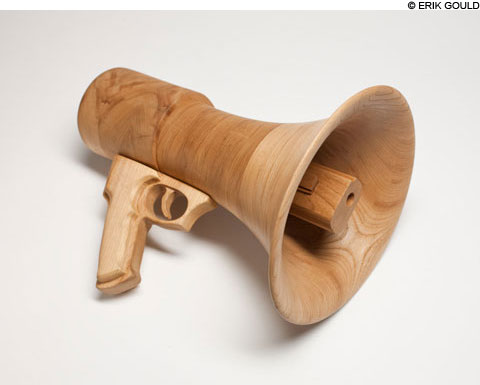
OCCUPYING PUBLIC SPACE Olmsted reimagined. |
Dale Broholm was touring the Civil War battlefields at Gettysburg a few years ago when his friend, a former historian with the National Parks Service, described a landscape project that involved clearing trees. Broholm, a furniture maker and longtime faculty member at the Rhode Island School of Design, had a question: "What becomes of these trees?"
Today, the National Parks Service notifies Broholm when trees are being cleared. And for the last three years, these "witness trees" — trees that have "witnessed" key events in American history — have been at the center of a class he co-teaches with RISD's History Philosophy and Social Sciences (HPSS) department head Daniel Cavicchi.
In 2009, when NPS sent RISD a tree from an historic plantation outside Baltimore, the "Witness Tree Project" class discussed slavery and the post-Civil War South — and fashioned the tree into objects evoking the topic. The following year, when the pair received wood from the birthplace of George Washington and the homestead of Theodore Roosevelt, the discussion — and craftsmanship — turned to the presidency's role in democratic life.
Last year, it was the remains of the stately elm that stood for nearly two centuries in Frederick Law Olmsted's former backyard — now the NPS-operated Frederick Law Olmsted National Historic Site — in Brookline, Massachusetts. Despite therapeutic injections and careful pruning, the tree had lost its battle with Dutch Elm Disease. And so, in the spring, workers carefully extracted it, sent the trunk to be sawed and dried, and shipped the pieces to Providence.
The tree had become a textbook. And Olmsted — farmer, sailor, merchant, journalist, gold mine manager, and undisputed king of American landscape architecture, thanks to his designs for New York City's Central Park and the grounds of the US Capitol, among countless other commissions — had added another line to his resume. At age 189, he was now a teacher at the Rhode Island School of Design.
Sure, Olmsted didn't technically speak to "Witness Tree Project" students. But Broholm and Cavicchi did everything in their power to summon his spirit. At the beginning of the semester, the class made a pilgrimage to the Olmsted home. In the following weeks, Cavicchi assigned readings by Olmsted about the role of green space in cities. Broholm, meanwhile, took students to the furniture studio to create objects interpreting Olmsted's many occupations, 19th-century leisure activities, and the use of public space in American history.
On Friday, the tree returned to Brookline in drastically re-imagined form, with the opening of the "Echoes of the Olmsted Elm" exhibition (running through the end of September) — each student's piece crafted from the rich, perfectly sanded wood of a tree that once stood only yards away.
The leisure objects ranged from alpine skis and juggling pins to sandbox toys and wine decanters. For the contemplation of public space, Industrial Design student Christina Xu crafted an Occupy-inspired megaphone with a handgun trigger. "The ability to generate noise evokes fear and poses a threat to the American government, causing police to view this noise a weapon," she writes in an accompanying essay. "Some see noise as a freedom; others see it as a crime."